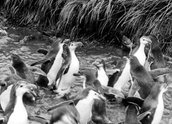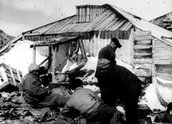


Siege of the South (1931)
Synopsis
Between 1929 and 1931, Sir Douglas Mawson led two summer expeditions to Antarctica in the ship Discovery as part of a British, Australian and New Zealand Antarctic Research Expedition (BANZARE). The main purpose of the expedition was to conduct oceanographic and mapping work and to collect samples of marine biology. Cameraman, adventurer and photographer Captain Frank Hurley accompanied the expedition to record their second journey on film. They departed Hobart on 22 November 1930.
Curator’s notes
Frank Hurley had already made two films of Antarctic expeditions – Sir Douglas Mawson’s treacherous expedition to the Magnetic South Pole in 1913-14 and Sir Ernest Shackleton’s voyage to the Antarctic three years later. In his second trip with Mawson, almost twenty years after the first, Hurley again captured the drama and delight of Antarctic exploration and adventure. The resulting film, Siege of the South, is perhaps less naturally spectacular than the record of Mawson’s Australasian Antarctic Expedition mission Home of the Blizzard (1913), but this is probably due more to the fact that this time around, the expedition only spent a very brief period on land and less than a year at sea.
Hurley was frustrated with this fact, writing in his diary on his return ‘this meagre time has seriously affected the kinema record … to expect me to make a film of Antarctica in a few hours is ridiculous’ (McGregor, A 2004, Frank Hurley: A photographer’s life, Viking, Camberwell, p. 323). This may explain the novelty props used in the film and staged scenes filmed for the camera. These included a gramophone which was placed amongst the penguins (to their great displeasure) at Cape Denison (see clip two), a Mickey Mouse cut-out which popped up at various intervals on their journey, and a race to the shoreline by members of the crew riding on the backs of distressed elephant seals. On a more serious note, Hurley records the sealers and whalers of the area, the great ice monoliths of the Antarctic, excursions in the seaplane, the coaling of the ship and the expedition’s return to Commonwealth Bay.
By the 1930s, technology enabled Hurley to record his narration for the film on sound disc (which saved him giving repeated live lectures) and for the addition of Antarctic sound effects and music (most notably sea shanties). Hurley’s recorded narration (added to keep up with the newly arrived ‘talkies’) added immediacy to the footage much like his live commentaries would have done for both Home of the Blizzard (1913) and Endurance (first released as In the Grip of the Polar Ice in 1917). His optimistic and laid-back style is recognisably Hurley, and was refined through the extensive touring and live presentations which accompanied the other Antarctica films. The first commercially released version of Siege of the South was in fact silent; Southward Ho with Mawson was released in 1930 and you can read more about it on the NFSA website.
As a result of the 2nd BANZARE expedition a large area of the Antarctic coast was mapped for the first time, the crew engaged in scientific research which added to the depth of oceanographic knowledge and Mawson claimed British possession of part of Antarctica. Hurley’s audiovisual record documents Australia’s rich history of scientific exploration of what is now known as the Australian Antarctic Territory. Together with Home of the Blizzard (1913) and Endurance (1917), Siege of the South is a great achievement in Antarctic actuality filmmaking.
The film premiered at Brisbane’s Majestic Theatre in October 1931, with Hurley introducing the program.
- Overview
- Curator’s notes
- Video 3 clips

- Principal credits
- Find a copy
- Make a comment
- Extras
- Add your review



